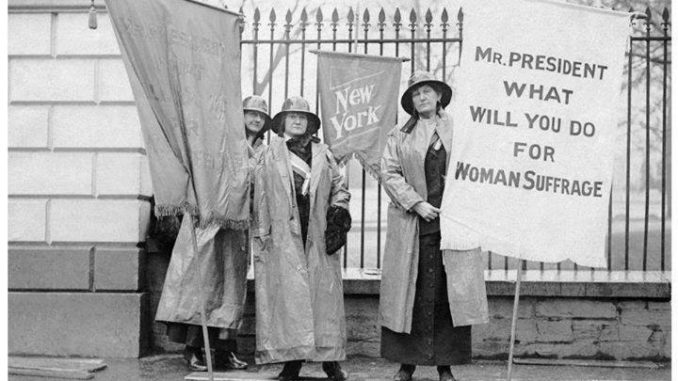
Cherry Sokoloski
This month, Americans are celebrating the 100th anniversary of the 19th Amendment to the U.S. Constitution, enfranchising the women of this country at long last. The final years of the fight for women’s suffrage were highly dramatic, thanks in large part to the courage and tenacity of a remarkable woman, Alice Paul (1885-1977).
Paul’s approach was anything but polite. Her strategy was to embarrass President Woodrow Wilson for his stand against suffrage, and she actively campaigned against Wilson and his entire Democratic party during the 1916 election. Wilson won by a small margin.
Paul had an early education in radical politics. In 1907, in her early 20s, she traveled to England to further her studies. There was a strong organization in Great Britain at the time working to gain more rights for women, including the right to vote. These women used strategies that were much more militant than those of their sisters in the United States – such as throwing bricks through windows and going on hunger strikes.
Paul became involved with the group and was jailed three times for her participation.
When she returned to the U.S., Paul joined the National American Woman Suffrage Association and tried, unsuccessfully, to convince the organization to use some of the English tactics. The NAWSA, which had become quite conservative, was primarily working to gain the vote on a state-by-state basis. This strategy found favor with many politicians since it was slow as molasses.
Paul and Lucy Burns started their own organization in 1913 called the Congressional Union for Woman’s Suffrage, later renamed the National Woman’s Party.
However, Paul undertook one last project with the NAWSA, an elaborate parade in Washington, D.C. in 1913, on the eve of President Woodrow Wilson’s inauguration. About 8,000 women marched down Pennsylvania Avenue that day, including the famous Chicago suffragist Ida B. Wells-Barnett.
The parade was only the beginning of a five-year battle with the president, one that Paul and other suffragists would eventually win.
Perhaps Wilson should have guessed the strength of his adversary. The night before his inauguration in 1913, he arrived in D.C. to find no adoring crowds awaiting him. Asked where all the people were, an aide informed him that they were all watching the women’s suffrage parade.
A new approach
In 1917, following President Wilson’s reelection, the National Woman’s Party was looking for a new way to influence him. Another leader in the party, Harriot Stanton Blatch (daughter of the famed suffragist Elizabeth Cady Stanton) had a dramatic idea: the suffragists could organize a picketing campaign in front of the White House. No one had ever picketed the White House before.
The picketers carried banners with messages such as “Mr. President, What Will You Do for Woman Suffrage?” But they did not speak to each other or to people on the street, so they were called the “Silent Sentinels.” The picketing began in the bitter cold of January 1917; it continued, six days a week, for almost two years.
In April of 1917, the U.S. entered World War I, and there was considerable pressure on the suffragists to quit their activities and focus on the war. Their suffrage work was “unpatriotic,” most people thought. More conservative suffragists – and even Paul’s mother – agreed with the critics.
Paul and her followers were not moved. The protesters used Wilson’s own words against him, carrying banners ridiculing his goal of “making the world safe for democracy” while denying democratic participation for women in his own country. Later, they resorted to burning Wilson’s speeches and even burned him in effigy in front of the White House.
Almost two thousand women, representing more than half the states, participated in the picketing campaign.
Jailed and abused
Paul, Burns and several other members of the NWP were eventually arrested and jailed in the Occaquan Workhouse in Virginia. The women endured cold cells, filthy floors and blankets, and brutality from the guards. They held hunger strikes and were force-fed through tubes, a cruel practice. They were also denied any communication with the outside world.
Eventually, however, word of their plight did escape the prison walls, and when the women’s treatment became known there was a general public outrage. The workhouse experience, dreadful as it was, helped to turn the tide of public opinion in favor of the suffragists.
This new public favor, plus the political fact that women could already vote for president in 18 states, finally persuaded President Wilson to change his mind. He announced his support of the 19th Amendment on Jan. 9, 1918. The next day, the U.S. House of Representatives voted in favor of the amendment, but it took another year and a half before the U.S. Senate passed the measure.
Even that was not the end of the story. The 19th Amendment still had to be ratified by 75 percent of the states – which at that time was 36 states.
Next month, we will look at the fascinating finale of the suffrage drama, dubbed the “War of the Roses.” It’s the story of how Tennessee became the 36th state to ratify the 19th Amendment.
Sources: Sisters: The Lives of America’s Suffragists by Jean H. Baker, 2005; Votes for Women by Winifred Conkling, 2018; Women’s Right to Vote: America’s Suffrage Movement by Katie Marsico, 2011.
Support Northern Colorado Journalism
Show your support for North Forty News by helping us produce more content. It's a kind and simple gesture that will help us continue to bring more content to you.
BONUS - Donors get a link in their receipt to sign up for our once-per-week instant text messaging alert. Get your e-copy of North Forty News the moment it is released!
Click to Donate
